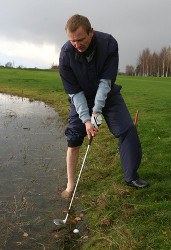
What is a Plunk in Golf?
A “plunk” is a term used in golf to describe a shot that lands with a loud sound, typically indicating that the ball has hit the water hazard. It can be frustrating for golfers as it usually results in a penalty stroke.
-
Causes of a Plunk
There are several reasons why a golfer may experience a plunk:
- The golfer may have hit the ball off-target, aiming too close to the water hazard.
- The wind direction and speed can also affect the path of the ball, potentially leading it into a water hazard.
- Poor club selection or distance judgment can result in a shot that falls short, landing in the water.
-
Penalties for a Plunk
When a golfer's ball goes into a water hazard, they typically receive a one-stroke penalty. They must then proceed to the designated drop area or replay the shot from where they originally hit it, according to the rules of the golf course.
-
Strategies to Avoid Plunks
While avoiding all plunks in golf is nearly impossible, there are strategies that golfers can employ to minimize their chances of hitting into a water hazard:
- Course Management: Golfers should assess the layout of the course and plan their shots accordingly. Avoiding water hazards can often be achieved by strategically placing shots away from the hazard.
- Club Selection: Choosing the appropriate club for the distance and conditions is essential. Using a club that ensures enough power to clear the water hazards can reduce the risk of a plunk.
- Shot Execution: Proper swing technique, accuracy, and focus are vital for hitting shots that avoid water hazards. Taking the time to line up shots and execute them correctly can help golfers steer clear of plunks.
-
Mental Approach
Dealing with the frustration of a plunk can be a mental challenge. Golfers should approach the game with a positive mindset and not let a single shot dictate their overall performance. Recognizing that mistakes happen and focusing on the next shot can help overcome the disappointment of a plunk.
-
Importance of Course Knowledge
Being familiar with the course's layout and potential hazards is crucial. Reviewing course maps, paying attention to markers, and seeking advice from experienced golfers or course staff can provide valuable insight into the location and nature of water hazards. This knowledge can help golfers make informed decisions and avoid plunks.
In conclusion, a plunk in golf refers to a shot that lands in a water hazard with a loud sound, resulting in a penalty stroke. While avoiding all plunks is challenging, implementing strategies such as course management, proper club selection, shot execution, and maintaining a positive mental approach can help minimize the likelihood of hitting into water hazards. Course knowledge is also vital for making informed decisions and navigating around potential plunk-inducing hazards. Happy golfing!





